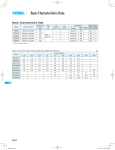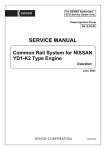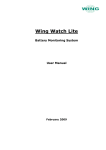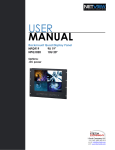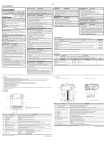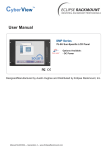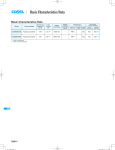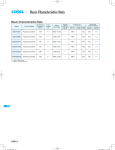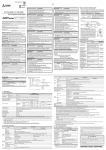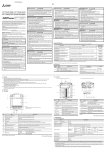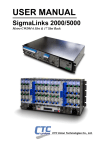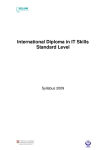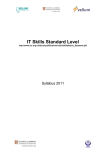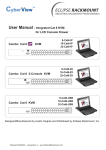Download Basic characteristics data • Instruction manual
Transcript
Basic Characteristics Data Basic Characteristics Data Model Circuit method CQHS250 Full-bridge converter Switching frequency [kHz] Input current Rated input fuse Inrush current protection Material 140 *1 - - glass fabric base, epoxy resin Series/Redundancy operation availability PCB/Pattern Single sided Double sided Series operation Redundancy operation Multilayer Yes *2 CQHS300 Forward converter 250 *1 - - Aluminum Yes Yes *2 CQHS350 Forward converter 250 *1 - - Aluminum Yes Yes *2 *1 Refer to Specification. *2 Refer to Instruction Manual. CQHS CQHS-8 DC-DC Converters Bus Converter.Power Module Type Instruction Manual 1 Pin Configuration CQHS-10 2 Connection for Standard Use CQHS-10 3 Wiring Input/Output Pin CQHS-11 4 5 6 7 3.1 Wiring input pin CQHS-11 3.2 Wiring output pin CQHS-11 Function CQHS-12 4.1 Overcurrent protection and Low voltage protection CQHS-12 4.2 Overvoltage protection CQHS-12 4.3 Thermal protection CQHS-12 4.4 Remote ON/OFF CQHS-13 4.5 Remote sensing CQHS-13 4.6 Adjustable voltage range CQHS-14 4.7 Withstanding Voltage / Isolation Voltage CQHS-14 Series and Parallel Operation CQHS-15 5.1 Series operation CQHS-15 5.2 Redundancy operation CQHS-15 Implementation-Mounting Method CQHS-15 6.1 Mounting method CQHS-15 6.2 Stress onto the pins CQHS-16 6.3 Cleaning CQHS-16 6.4 Soldering temperature CQHS-16 6.5 Derating CQHS-16 6.6 Heat sink (CQHS300/CQHS350 Optional parts) CQHS-17 Safety Considerations CQHS-18 CQHS-9 CQHS DC-DC Converters Bus Converter . Power Module Type 1 Pin Configuration 2 Connection for Standard Use ¿ CQHS250 8 7 6 5 4 -VIN 3 RC 2 +VIN 1 Instruction Manual -VOUT -S TRM +S +VOUT ¡The power module needs input and output connection as shown in Fig.2.1 or Fig.2.2. Reference: 3 ”Wiring Input/Output Pin” 6.5 ”Derating” ¡Short the following pins to turn on the power supply. -VIN RC, +VOUT +S, -VOUT -S Reference: 4.4 ¿ CQHS300/CQHS350 ”Remote ON/OFF” 4.5 ”Remote sensing” 2-Mounting hole ¡Only DC voltage can be applied to CQHS Series. Applying AC voltage will damage the power module. ¿ CQHS250 8 7 6 5 4 -VIN 3 RC 2 +VIN 1 -VOUT -S TRM +S +VOUT F1 DC input +VIN Cin Cout + RC -VIN Table 1.1 Pin Assignment No. 1 2 3 4 5 6 7 8 - Pin Name +VIN RC -VIN +VOUT +S TRM -S -VOUT Mounting hole Function +DC input Remote ON/OFF -DC input +DC output +Remote sensing Adjustment of output voltage -Remote sensing -DC output Mounting hole No. 1 2 3 4 5 6 7 8 - Pin Name +VIN RC -VIN +VOUT +S TRM -S -VOUT Mounting hole Reference 3.1 ”Wiring input pin ” 4.4 ”Remote ON/OFF ” 3.1 ”Wiring input pin ” 3.2 ”Wiring output pin ” 4.5 ”Remote sensing ” 4.6 ”Adjustable voltage range ” 4.5 ”Remote sensing ” 3.2 ”Wiring output pin ” 6.1 ”Mounting method ” CQHS-10 + Load -VOUT -S Fig.2.1 Connection for Standard Use (CQHS250) Fig.1.1 Pin configuration (bottom view) CQHS +S +VOUT ¿ CQHS300/CQHS350 Heat sink F1 DC input CY Cin + Mounting hole +VIN +S +VOUT Cout RC -VIN + Load -VOUT -S Fig.2.2 Connection for Standard Use (CQHS300/CQHS350) Table 2.1 External components No. Symbol Component 1 F1 Input fuse Primary decoupling 2 CY capacitor External capacitor 3 Cin on the input side External capacitor 4 Cout on the output side Heat sink 5 Reference 3.1(1) ”External fuse” 3.1(2) ”Noise Filter/Decoupling Capacitor” 3.1(3) ”External capacitor on the Input” 3.2 ”Wiring output pin” 6.5 ”Derating” DC-DC Converters Bus Converter . Power Module Type 3 Wiring Input/Output Pin 3.1 Wiring input pin Instruction Manual (4) Input Voltage Range/Input Current Range ¡Keep the input voltage ripple within the specification below. Output ripple voltage will increase as these values increase. Ripple voltage CQHS250/300/350 : less than 4Vp-p ¡Make sure that the peak input voltage stays within the specified input voltage range of the power module. (1) External fuse ¡The input circuit of CQHS Series does not come with a built-in fuse. In order to protect the power module, a normal-blow fuse ¡Choose a front end power supply that can supply enough current Ip (Fig. 3.2) for starting up the power module. Table 3.1 Recommended fuses (Normal-blow type) Model CQHS25048 CQHS30048 CQHS35048 Rated current 15A 20A 20A Ripple voltage Time Input voltage range ule. Input voltage [V] should be installed to +VIN. ¡When multiple modules get input voltage from a single front-end power supply, a normal-blow fuse must be installed to each mod- t Fig.3.1 Input Voltage Ripple (2) Noise Filter/Decoupling Capacitor Input voltage range Input current [A] ¡An appropriate filter must be used if conformance to the conducted noise regulation is required or if surge voltage may be applied to the unit. Please consult us for more details. ¿ CQHS300/CQHS350 ¡A decoupling capacitor CY must be used to reduce the line noise on the input line and stabilize the power module operation (Fig. Input voltage [V] Fig.3.2 Input Current Characteristics 2.2). Note that resonance and inductance from the input line filter may cause the power module to become unstable. ¡Install a decoupling capacitor CY of at least 4700 pF as close to the input pins as possible (within 50mm of the pins). ¡If the total capacitance of the decoupling capacitor exceeds 15000 pF, the specified isolation voltage between input and output may not be satisfied. In this case, either reduce the capacitance of the lp ¡Avoid applying reversed-polarity voltage to the power module as it will damage the power module. To protect the power module from reversed polarity voltage, installing an external diode as shown in Fig. 3.3 is recommended. +VIN DC IN -VIN decoupling capacitor at the input or install a decoupling capacitor to the output. (3) External capacitor on the Input ¡An external capacitor Cin must be installed between +VIN and -VIN to reduce line noise and stabilize the power module operation (Fig. 2.1 and Fig.2.2). Capacitance CQHS250/300/350 : at least 68 FX2 CQHS250 Ta=-20 to +85C Electrolytic or Ceramic capacitor Ta=-40 to +85C Ceramic capacitor CQHS300/CQHS350 Tc=-20 to +100C Electrolytic or Ceramic capacitor Tc=-40 to +100C Ceramic capacitor ¡The capacitor must be installed less than 50mm of the power module. As ripple current will flow through this capacitor, pay attention to the ripple current rating of the capacitor. CQHS (5) Reverse Input Voltage Protection Fig.3.3 Reverse Input Voltage Protection 3.2 Wiring output pin ¡Install an external capacitor Cout between +VOUT and -VOUT to increase stability of output (Fig. 2.1 and Fig.2.2). Recommended capacitance of Cout is shown in Table 3.2 and Table 3.3. ¡Choose a high frequency type electrolytic capacitor for Cout. Output ripple and rise time will be influenced by the capacitor’s ESR and ESL and the wiring impedance. ¡As ripple current will flow through capacitor Cout, pay attention to the ripple current rating of the capacitor. ¡Install capacitor Cout as close to the power module as possible (within 50mm). ¡If the power module is to be turned ON/OFF directly with a switch, inductance from the input line will induce a surge voltage several This is useful for reducing radiated noise and increasing stability times that of the input voltage and it may damage the power mod- ¡When the capacitance of external output capacitor Cout is high, it may unstabilize the operation of power supply, so please refer to ule. Make sure that the surge is absorbed, for example, by connecting an electrolytic capacitor between the input pins. of the power module operation. Table 3.2 and Table 3.3 for the value of the external capacitor Cout. CQHS-11 DC-DC Converters Bus Converter . Power Module Type Table 3.2 Capacitance Values for External Output Capacitor Cout [ F] (CQHS250) Recommended capacitance Ambient temperature Ta=-40~-20C Ta=-20~0C Ta=0~+85C 470 470 220 330 100 100 Output voltage(V) 32 50 2200 1000 Recommended capacitance Maximum Base plate temperature capacitance Tc=-40~-20C Tc=-20~0C Tc=0~+100C 470X2 470X2 470 3300 330X2 330 330 2200 32 50 ¡The specified ripple and ripple noise are measured by the method introduced in Fig. 3.4 and Fig.3.5. Measuring board +S +VIN 㧗VOUT Overcurrent protection prevents the unit from short circuit and overcurrent condition. ¡The DC output will be shut down, when the output voltage drops under the output voltage adjustment range (low voltage protection). ¡Recovery from the protection is accomplished by applying 5VDC or less input for at least 1 second, or toggling remote ON / OFF signal for at least 1 second. ¡Recovery from the protection is accomplished by applying 5VDC or less input for at least 1 second, or toggling remote ON / OFF signal for at least 1 second. + + RC 0.1mF Cout Load Remarks : Please note that devices inside the power supply might fail when -VIN -VOUT CQHS ¡Overcurrent protection is built-in and comes into effect at over 105% of the rated current. ¡The overvoltage protection circuit is built-in. The DC input should be shut down if overvoltage protection is in operation. 50mm Cin 4.1 Overcurrent protection and Low voltage protection 4.2 Overvoltage protection ¿ CQHS250 DC input 4 Function Maximum capacitance Table 3.3 Capacitance Values for External Output Capacitor Cout [ F] (CQHS300/CQHS350) Output voltage(V) Instruction Manual voltage more than rated output voltage is applied to output pin of the power supply. This could happen when the customer tests the -S overvoltage performance of the unit. Oscilloscope BW㧦100MHz 1. 5m 50W Coaxial Cable R C 4.3 Thermal protection R=50W C=0.01mF ¡Over Temperature Protection (OTP) is built in. If the temperature of PCB exceed 120C (CQHS250) or the base plate temperature Fig.3.4 Method of Measuring Output Ripple and Ripple Noise (CQHS250) exceed 100C (CQHS300/CQHS350). OTP will work, causing the output voltage to drop. ¡Recovery from the protection is accomplished by applying 5VDC or less input for at least 1 second, or toggling remote ON / OFF ¿ CQHS300/CQHS350 signal for at least 1 second, after the unit should be cool down. 50mm CY Measuring board Mounting +S 4700pF hole +VIN 㧗VOUT Cout Co DC input + + Cin ¡Option ”-N” means the output voltage of the power module will be recovered automatically when the fault condition (such as OCP, + RC 0.1mF Load -VIN -VOUT -S Oscilloscope BW㧦100MHz R C 1. 5m 50W Coaxial Cable R=50W C=0.01mF Co32V㧦470mF 50V㧦220mF Fig.3.5 Method of Measuring Output Ripple and Ripple Noise (CQHS300/CQHS350) CQHS-12 ¿ -N (CQHS250) OVP or OTP) is corrected. DC-DC Converters Bus Converter . Power Module Type Instruction Manual 4.4 Remote ON/OFF 4.5 Remote sensing ¡The remote ON/OFF function is incorporated in the input circuit and operated with RC and -VIN. If positive logic control is re- (1) When Remote Sensing is Not Used quired, order the power module with “-R” option. +S Table 4.1 Remote ON/OFF Specifications (CQHS250) ON/OFF logic Between RC and -VIN L level(0 - 1.0V) or short Standard Negative H level(4.0 - 7.0V) or open L level(0 - 1.0V) or short Optional Positive -R H level(4.0 - 7.0V) or open Output voltage ON OFF OFF ON ¡When RC is at low level, a current of 0.1mA typ will flow out. When Vcc is used, keep it within the following rage: 4 [ VCC [ 7V. When remote ON/OFF is not used, short RC and -VIN. +VOUT + Load Cout -VOUT -S Short at pin root Fig. 4.2 When Remote Sensing is Not Used ¡When remote sensing is not used, make sure +VOUT and +S are shorted, and that -VOUT and -S are shorted as well. ¡Keep the patterns between +S and +VOUT and between -S and -VOUT as short as possible. Avoid a looping pattern. If noise enters the loop, the operation of the power module will become unstable. Table 4.2 Remote ON/OFF Specifications (CQHS300/CQHS350) ON/OFF logic Between RC and -VIN L level(0 - 1.2V) or short Standard Negative H level(3.5 - 7.0V) or open L level(0 - 1.2V) or short Optional Positive -R H level(3.5 - 7.0V) or open (2) When Remote Sensing is Used Output voltage ON OFF OFF ON Wire as close as possible +S +VOUT ¡When RC is at low level, a current of 0.5mA typ will flow out. When Vcc is used, keep it within the following rage: -VOUT -S 3.5 [ VCC [ 7V. + Cout Load Fig. 4.3 When Remote Sensing is Used When remote ON/OFF is not used, short RC and -VIN. Vcc RC RC -VIN Opto coupler -VIN Transistor RC RC -VIN IC -VIN ¡Using remote sensing with long wires may cause output voltage to become unstable. Consult us if long sensing wiring is necessary. ¡Sensing patterns or wires should be as short as possible. If wires are used, use either twisted-pair or shielded wires. ¡Use wide PCB patterns or thick wires between the power module and the load. Line drop should be kept less than 0.3V. Make sure output voltage from the power module stays within the specified range. Relay Fig. 4.1 RC Connection Example ¡If the sensing patterns are shorted by mistake, a large current may flow and damage the pattern. This can be prevented by installing fuses or resistors close to the load. As wiring or load impedance may generate oscillation or large fluctuations in output voltage, make sure enough evaluation is given in advance. CQHS-13 CQHS DC-DC Converters Bus Converter . Power Module Type (3) Output voltage increasing 4.6 Adjustable voltage range ¡By connecting the external resistor (RU), output voltage becomes adjustable to increase. (1) Output voltage adjusting ¡Output voltage is adjustable by the external potentiometer. ¡When the output voltage adjustment is used, note that the over The external resistor (RU) is calculated the following equation. voltage protection circuit operates when the output voltage sets VORX㧔100㧑+ 㧑㧕 RU= too high. ¡If the output voltage drops under the output voltage adjustment range, note that the Low voltage protection operates. recommended external parts are shown in Table 4.2. ¡The wiring to the potentiometer should be as short as possible. The temperature coefficient becomes worse, depending on the 1 VR1 5kW 3 -S -VOUT Fig. 4.4 Output voltage control circuit Table 4.2 Recommended Values of External Resistors 1 2 32V 50V ¡By connecting the external resistor(RD), output voltage becomes adjustable to decrease. The external resistor(RD) is calculated the following equation. 100㧑 㧑= Δ㧑 -2 [kW] VOR㧙VOD VOR 90 32 85 0 0 38 36 40 42 100 50 90 32 84 0 0 INPUT VOLTAGE [V] 36 38 40 42 INPUT VOLTAGE [V] CQHS25048 Fig. 4.7 Output voltage adjustment range (5) Output current derating (CQHS3504832) X100 12.0 11.5 11.0 10.5 10.0 0 0 26.88 28.0 32.0 35.2 Output voltage [V] Fig. 4.8 Output Current derating curve (CQHS3504832) CQHS +VOUT +S VOR :Rated output voltage[V] VOD :Output voltage needed to set up[V] TRM RD -S -VOUT Fig. 4.5 Connection for output voltage decreasing CQHS-14 50 32, 50 110 ¡When the output voltage adjust less than rated output voltage, the output current range becomes increasing as shown in Fig. 4.8. (2) Output voltage decreasing RD= 100 Output current [A] VOUT Adjustable range VOUT±5% VOUT±10% R1 R2 R1 R2 51kW 51kW 11kW 6.2kW 82kW 82kW 32, 50 110 ADJUSTMENT RANGE [%] ¡When the input voltage is 36 - 40VDC , the output voltage adjustment range becomes as shown in Fig. 4.7. ADJUSTMENT RANGE [%] +S TRM R2 2 No. Fig. 4.6 Connection for output voltage increasing (4) Intput voltage derating 2.5V RC 1kW VOR :Rated output voltage[V] VOU :Output voltage needed to set up[V] +VOUT R1 RB 2kW X100 -S -VOUT ¡When the output voltage adjustment is not used, open the TRM pin respectively. CQHS ާkWި TRM Potentiometer....Cermet type, coefficient of less than ±300ppm/C 㧗 VOR 㧑 RU mended for the power supply. Resistor.............Metal film type, coefficient of less than ±100ppm/C RA 2kW VOU-VOR CQHS +VOUT +S type of a resistor and potentiometer. Following parts are recom- Control Amp. of rated 㧙 voltage 㧔100㧑+2X 㧑㧕 1.225X 㧑 㧑= ¡By connecting the external potentiometer (VR1)and resistors (R1,R2),output voltage becomes adjustable, as shown in Fig.4.4, CQHS Instruction Manual 4.7 Withstanding Voltage / Isolation Voltage ¡When testing the withstanding voltage, make sure the voltage is increased gradually. When turning off, reduce the voltage gradually by using the dial of the hi-pot tester. Do not use a voltage tester with a timer as it may generate voltage several times as large as the applied voltage. DC-DC Converters Bus Converter . Power Module Type 5 Series and Parallel Operation Instruction Manual 6 ImplementationMounting Method 5.1 Series operation 6.1 Mounting method ¡Series operation is available by connecting the outputs of two or more power supplies, as shown below. Output current in series ¡When multiple power modules are used side by side, position them with sufficient spaces to allow adequate air ventilation so connection should be lower than the lowest rated current in each that the temperature of each power module will remain within the unit. temperature range shown in the derating curves. (a) ¡Do not pass the DC input pattern underneath the power module as this will increase conducted noise. Place the DC input pattern Power + Supply Load away from the power module. Do not pass the DC output pattern underneath the power module as this will increase output noise. Place the DC output pattern Power + Supply Power + Supply - on the PCB to let it act as a shield and connect this pattern to the Load (b) away from the power module. ¡High frequency noise is radiated from the power module. When mounting the power module on a PCB, leave a copper pattern mounting hole. Power + Supply - Load ¿ CQHS250 ¡Avoid placing pattern layout in hatched area shown in Fig.6.1 to insulate between pattern and power supply. 48.5 Fig. 5.1 Examples of series operation 5.2 Redundancy operation +VIN ¡Parallel operation is not possible. ¡Redundancy operation is available by wiring as shown below. +VOUT +S TRM -S -VOUT RC -VIN +S +VOUT I1 I3 Fig.6.1 Prohibition area of pattern layout (top view) Load -VOUT -S +S +VOUT CQHS 5.0 I2 -VOUT -S Fig. 5.2 Example of Redundancy Operation ¿ CQHS300/CQHS350 ¡Soldering CQHS series with printed board must be done under the flat condition by using the mounting hole and fixing with the screw. If CQHS series is inclined and it’s mounted, the insulation of the internal components and printed board might not be kept. ¡Even a slight difference in output voltage can affect the balance between the values of I1 and I2. Please make sure that the value of I3 does not exceed the rated current of a power supply. I3 the rated current value ¡When a heat sink cannot be fixed on the base plate side, order the power module with ”-T” option. A heat sink can be mounted by affixing a M3 tap on the heat sink. Please make sure a mounting hole will be connected to a grounding capacitor CY. Table 6.1 Mounting Hole Configuration Standard Optional : -T Mounting hole M3 tapped f3.4 thru CQHS-15 DC-DC Converters Bus Converter . Power Module Type Instruction Manual 6.2 Stress onto the pins 6.5 Derating ¡Applying excessive stress to the input or output pins of the power module may damage internal connections. Avoid applying stress ¡It is necessary to note the thermal fatigue life by power cycle. Please reduce the temperature fl uctuation range as much as in excess of that shown in Fig. 6.2 and Fig.6.3. possible when the up and down of the temperature are frequently ¡Input and output pins are soldered onto the internal PCB. Do not bend or pull the leads with excessive force. generated. Contact us for more information on cooling methods. ¿ CQHS300/CQHS350 ¿ CQHS250 ¡As unexpected stress may be applied to the pins, set the diameter of the PCB mounting hole at 3.5mm. ¡Use with the convection cooling or the forced air cooling. Make sure the temperatures at temperature measurement loca- ¡As unexpected stress may be applied to the pins from vibration or shock, fix the power module by using the mounting holes with tions shown from Fig.6.4 below are on or under the derating curve Ambient temperature must be kept at 85C or under. ¡Fix the power module to the PCB with the screws before soldering the input and output pins to prevent the PCB pattern being damaged. -VOUT -S TRM +S +VOUT -VIN RC +VIN +VOUT, -VOUT Less than 19.6N(2kgf) 100 80 60 40 20 0 -40 -20 Less than 19.6N Less than 19.6N(2kgf) Less than 39.2N 40 60 80 100 Temperature of measurement location +VIN +VOUT, -VOUT Others Less than 9.8N(1kgf) Less than 39.2N(4kgf) ¡For option “B” which is used with the convection cooling, forced air cooling or conduction cooling, use the temperature measurement location as shown in Fig.6.5. 1Vin=DC36-60V CQHS2504850 100 Load factor[%] RC Less than 9.8N(1kgf) Less than 19.6N(2kgf) ¡Clean the soldered side of the power module with a brush. Prevent liquid from getting into the power module. Do not clean by soaking the power module into liquid. ¡Do not allow solvent to come in contact with product labels in cases as this may cause deletion of the letters printed on the product CQHS2504832 60 40 Vin : 36 - 60V 20 -20 0 20 40 60 (75)80(85) 100 Aluminum base plate temperature Tc [ C ] 2Vin=DC60-76V 100 Load factor[%] 6.3 Cleaning 80 0 -40 Fig. 6.3 Stress onto Pins (CQHS300/CQHS350) 80 60 Vin : 60 - 76V 40 (25) 20 0 -40 -20 20 40 60(65) 80 (95)100 0 Aluminum base plate temperature Tc [ C ] labels. ¡After cleaning, dry the power modules well. 6.4 Soldering temperature ¡Flow soldering : 260C for up to 15 seconds. ¡Soldering iron (26W) : 450C for up to 5 seconds. CQHS-16 120 Fig. 6.4 Derating curve (CQHS250) -VOUT -S TRM +S +VOUT -VIN Less than 19.6N(2kgf) 20 Less than 19.6N Fig. 6.2 Stress onto Pins (CQHS250) Less than 19.6N(2kgf) 0 Temperature of measurement location[C] Others Less than 39.2N(4kgf) CQHS in Fig.6.4. Load factor[%] screws to reduce stress. Aluminum base plate Tc : Measuring point Fig. 6.5 Derating curve (CQHS250 option "B") DC-DC Converters Bus Converter . Power Module Type ¿ CQHS300/CQHS350 ¡Use the power modules with conduction cooling (e.g. heat dissipation from the aluminum base plate to the attached heat sink). Instruction Manual 6.6 Heat sink (CQHS300/CQHS350 Optional parts) Fig. 6.6 shows the derating curves with respect to the aluminum ¡CQHS300/CQHS350 works with conduction cooling and needs heat dissipation using heat sinks. Optional heat sinks are avail- base plate temperature. Note that operation within the hatched ar- able for CQHS Series. Refer to Table 6.2 for details on the thermal eas will cause a significant level of ripple and ripple noise. Contact resistance of heat sinks. us for more information on cooling methods. ¡Please measure the temperature on the aluminum base plate edge side when you cannot measure the temperature of the center part of the aluminum base plate. Table 6.2 Types of Heat Sinks Available Size[mm] No. Model 1 2 3 4 5 6 F-QB-F1 F-QB-F2 F-QB-F3 F-QB-F4 F-QB-F5 F-QB-F6 H W D 12.7 12.7 25.4 25.4 38.1 38.1 58.4 58.7 58.4 58.7 58.4 58.7 37.6 37.3 37.6 37.3 37.6 37.3 In this case, please take 5deg temperature margin from the derating characteristic of Fig. 6.6. 1Vin=DC36-60V 100 Thermal resistance[C/W] Convection Forced Air (0.1m/s) 14.0 7.5 5.0 Style Horizontal Vertical Horizontal Refer Fig.6.8 Vertical Horizontal Vertical W W Vin=DC36 - 60V Vin=36-60V 0 D D 50 -20 0 20 40 60 80 100 H (85) -40 H Load factor [%] 80 Aluminum base plate temperature Tc [C] CQHS Vertical Horizontal 2CQHS300 : Vin=DC60 - 76V CQHS350 : Vin=DC60 - 65V Fig.6.7 Heat Sink Types 100 10 CQHS300 : Vin=DC60 - 76V Vin=60-76V CQHS350 : Vin=DC60 - 65V 50 0 (95) -40 -20 0 20 40 60 80 Thermal resistance(C/w) Load factor [%] 80 8 F-QB -F1/F2 F-QB -F3/F4 F-QB -F5/F6 6 4 2 100 Aluminum base plate temperature Tc [C] Tc : Measuring point 0 0.0 0.5 1.0 1.5 2.0 Wind velocity(m/s) 2.5 3.0 Fig.6.8 Thermal Resistance of Heat Sink(Forced Air) Aluminum base plate Fig. 6.6 Derating curve (CQHS300/CQHS350) CQHS-17 DC-DC Converters Bus Converter . Power Module Type 7 Safety Considerations ¡To apply for safety standard approvals with the power module, the following conditions must be met. Consult us for more details. ¿The power modules must be used as a component power supply in end-use equipment. ¿Neither basic isolation nor double/reinforced isolation is provided across input, output and the base plate of the power module. If the power module is to be used with input voltage of more than 60VDC and needs basic or double/reinforced isolation, the required isolation must be provided in the construction of the final product. ¿Use external fuses that comply with safety standards at the in- put. CQHS CQHS-18 Instruction Manual












